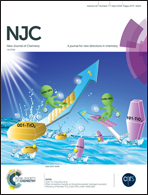Electrochemical behaviors and relativistic DFT calculations to understand the terminal ligand influence on the [Re6(μ3-Q)8X6]4− clusters†
Abstract
A Born–Haber thermodynamic cycle was used to determine the redox potential in a series of rhenium(III) clusters of the form [Re6(μ3-Q)8X6]4− where Q = S2− and Se2− and X = F−, Cl−, Br−, I−, CN−, NC−, SCN−, NCS−, OCN− and NCO−. Frequency analysis, relativistic and solvent effects were considered to estimate the free energy of the reversible process ReIII6/ReIII5ReIV at the DFT level. All the redox potentials were reported with respect to the standard hydrogen electrode (SHE) and show good agreement with the available experimental results. In general, the molecular orbitals involved in the redox process were localized in the cluster core, [Re6(μ3-Q)8]2+, and therefore the peripheral ligands act only as a modifier of the crystal-field strength, influencing the energy of the frontier molecular orbital splitting. Additionally, the theoretical approach was validated using an experimental protocol to study the electrochemical behavior of the [Re6(μ3-Se)8I6]3− cluster. An important first reversible reduction process was found at E1/2 = +0.47 V (SHE), which is in good agreement with the value predicted theoretically.
![Graphical abstract: Electrochemical behaviors and relativistic DFT calculations to understand the terminal ligand influence on the [Re6(μ3-Q)8X6]4− clusters](/en/Image/Get?imageInfo.ImageType=GA&imageInfo.ImageIdentifier.ManuscriptID=C7NJ05114J&imageInfo.ImageIdentifier.Year=2018)


 Please wait while we load your content...
Please wait while we load your content...